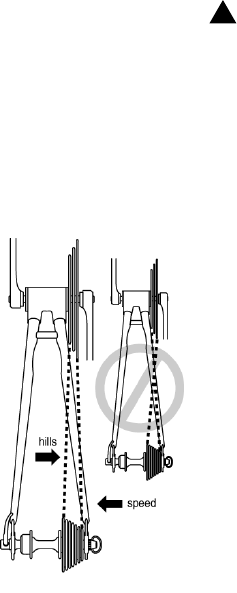
24
produce lower gear ratios. Using them requires less
pedaling effort, but takes you a shorter distance with
each pedal crank revolution. Moving the chain from a
smaller sprocket of the gear cluster to a larger sprocket
results in a downshift. Moving the chain from a larger
sprocket to a smaller sprocket results in an upshift. In order
for the derailleur to move the chain from one sprocket to
another, the rider must be pedaling forward.
c. Shifting The Front Derailleur:
The front derailleur, which is controlled by the left shifter,
shifts the chain between the larger and smaller chainrings.
Shifting the chain onto a smaller chainring makes pedaling
easier (a downshift). Shifting to a larger chainring makes
pedaling harder (an upshift).
d. Which Gear Should I Be In?
The combination of largest rear and smallest front gears
(g. 16) is for the steepest hills. The
smallest rear and largest front
combination (g. 21) is for the
greatest speed. It is not necessary
to shift gears in sequence.
Instead, nd the “starting gear”
which is right for your level of
ability — a gear which is hard
enough for quick acceleration
but easy enough to let you start
from a stop without wobbling
— and experiment with upshifting
and downshifting to get a feel for
the different gear combinations.
At rst, practice shifting where
there are no obstacles, hazards or
other trafc, until you’ve built up your condence. Learn
to anticipate the need to shift, and shift to a lower gear
before the hill gets too steep. If you have difculties with
shifting, the problem could be mechanical adjustment.
See your dealer for help.
!
WARNING: Never shift a derailleur onto the largest
or the smallest sprocket if the derailleur is not shifting
smoothly. The derailleur may be out of adjustment and the
chain could jam, causing you to lose control and fall.
2. How An Internal Gear Hub Drivetrain Works
If your bicycle has an internal gear hub drivetrain, the
gear changing mechanism will consist of:
• a 3, 5, 7 or possibly 12 speed internal gear hub
• one, or sometimes two shifters
• one or two control cables
• one front sprocket called a chainring
• a drive chain
a. Shifting Internal Gear Hub Gears
Shifting with an internal gear hub drivetrain is simply
a matter of moving the shifter to the indicated position
for the desired gear. After you have moved the shifter
to the gear position of your choice, ease the pressure
on the pedals for an instant to allow the hub to
complete the shift.
b. Which Gear Should I Be In?
The numerically lowest gear (1) is for the steepest hills.
The numerically largest gear (3, 5, 7 or 12, depending on the
number of speeds of your hub) is for the greatest speed.
Shifting from an easier, “slower” gear (like 1) to a


















